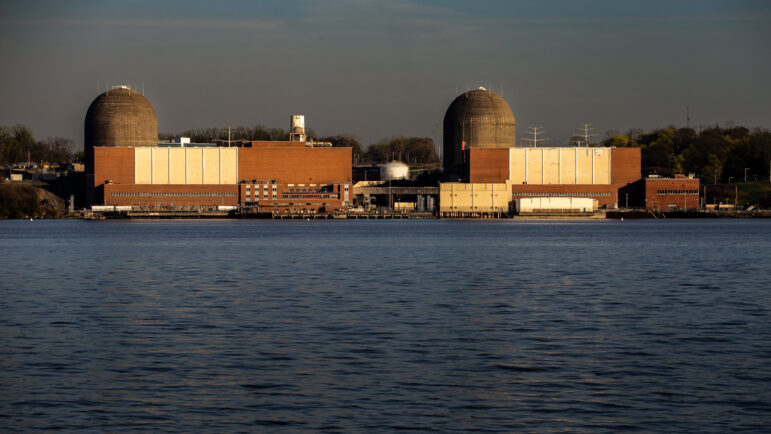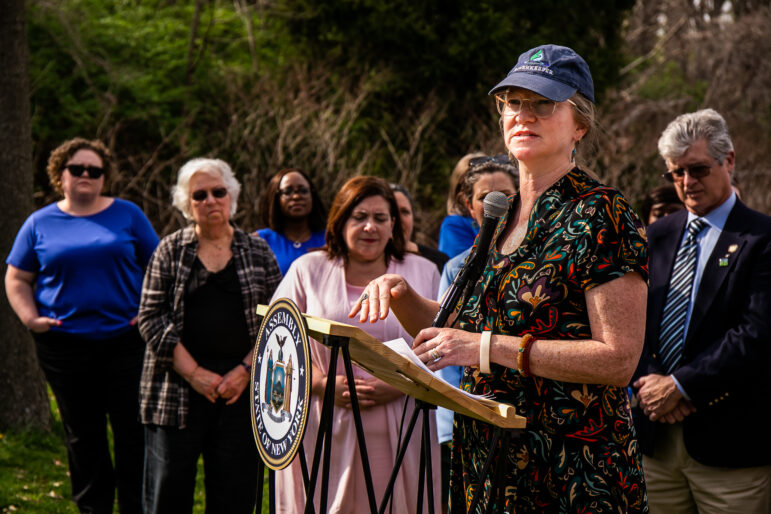The deactivated nuclear power plant, now run by Holtec, wants to discharge 1 million gallons of radioactive waste into the river as early as August. The dumping will release into the air and waterways an element called tritium that can increase the risk of cancer and lead to miscarriages and birth defects.

Adi Talwar
Courtney Williams with her husband Eric and their 13-year-old daughter next to the Hudson River.When Courtney Williams heard that a deactivated nuclear power plant, Indian Point, would start dumping more than 1 million gallons of radioactive water into the nearby Hudson River this summer, she immediately thought of her 10-year-old son.
“I signed my kid up to learn how to sail with his best buddy. And now I have to ask myself: is that really going to be safe for him?” Williams pondered. A cancer researcher who lives in Peekskill, New York, she spent her entire life in the Hudson Valley. Her mother, a registered nurse, even worked at Indian Point for a time.
Williams has joined over 440,000 people in signing a petition to stop Holtec International, the company that now owns Indian Point, from moving forward with the dumping plan, and is part of a coalition looking to finally put an end to the practice of discharging the plant’s waste into the waterway, which was quietly done for years when the facility was still open.
Over 100 environmental organizations sent a letter Monday asking Gov. Kathy Hochul to take action against Holtec, while U.S Senators Chuck Schumer and Kirsten Gillibrand expressed concerns in a letter of their own. Three New York counties and more than 20 municipalities have also passed resolutions in opposition.
That groundswell of resistance propelled Holtec to rethink its plan to dump the water in May, announcing they would “pause” the procedure—for now. They still plan to discharge the liquid into the river regardless, and said they could start the process as early as August.
Holtec guarantees the waste will be discharged in batches and undergo a filtering process first, arguing Indian Point similarly disposed of waste this way while it was active. But the company also admitted that its filters can’t eliminate a radioactive element called tritium that can increase the risk of cancer and lead to miscarriages and birth defects.
“I think Holtec is not looking out for [the community]. They’re simply looking out for their bottom dollar,” said Santosh Nandabalan from the environmental group Food & Water Watch, which is planning a rally against the company on Thursday.
Discharging into the river for decades
Founded in 1962, Indian Point once operated with three reactors. One shut down just 12 years into its existence, but the other two remained active until nonprofit Riverkeeper spearheaded a decade-long legal battle to shutter the plant due to environmental and safety concerns. In 2017, an agreement was finally reached with previous owner Enteergy to cease operations for good.
When the site shut down in April of 2021, Holtec became responsible for safely removing all materials from Indian Point and returning it to a usable state in a federally regulated process known as decommissioning. To cover the costs, New York state agreed to give the company a $2.4 billion trust fund paid for by taxpayers. In 2019, the company said it would cost them a little over $2.3 billion to decommission the plant.
The water Holtec is trying to get rid of was used to cool off and then store “spent fuel”—a giant assembly of parts that work together to create nuclear power. These assemblies have been sitting inside baths of water in the facility known as “spent fuel pools” since the 1970s. The longer the fuel is there, the more radioactive the water around it can become.
The cheapest way to get rid of radioactive liquid is to dump it into the river, environmentalists say. But there are other options, like storing it in special containers on site until it loses its radioactivity over time, or transporting it to a landfill facility elsewhere, where it would get buried deep underground.
State Sen. Peter Harckham, who has been active in trying to stop the dumping—he sponsored a bill earlier this year to prohibit “the discharge of any radiological agent into the waters of the state”—said the nature of New York’s contract with Holtec incentivizes the company to choose the least costly route.
Once decommissioning is complete, any portion of the $2.4 billion trust fund that Holtec doesn’t use is their profit to keep. “So that would encourage people to cut corners and move rapidly, as opposed to moving prudently,” Harckham told City Limits.
But Holtec said its plan isn’t novel: in a fact sheet shared with stakeholders, the company noted that “Indian Point has legally discharged to the river for over 60 years.”

Adi Talwar
A view of the Indian Point Nuclear Power Plant from across the Hudson River.
Nearly 460 thousand gallons of water from the spent fuel pool at Indian Point’s first unit, which shut down in the 1970s, was dumped into the Hudson River in 2008. Then, liquid from units two and three used to clean-up and cool several parts of the nuclear facility would get mixed in with some spent fuel pool water and discharged into the river too.
Thomas Congdon, chair of the Decommissioning Oversight Board created by the state to oversee the plant’s closure, claims that when the plant was still operating, they were discharging an average of “two to three million gallons [of wastewater] every year.”
Scientists warn, however, that the new batch being discharged could be more damaging than what was dumped in the past as the highly radioactive spent fuel assemblies have been bathing in it for over 40 years. Holtec has yet to publicly share data on sampled water from these pools.
“The longer the fuel is in there, the more radioactive the water can become,” said engineer David Lochbaum, former director of the Nuclear Safety Project for the Union of Concerned Scientists, who has been working closely with Holtec, and has defended the company’s disposal plan. “Until you remove the fuel, it’s just going to get worse with time.”
Patrick O’Brien, director of government affairs and communications at Holtec, told City Limits that there are 1,300 assemblies of spent fuel still sitting in one of the pools that is set to be drained and discharged this summer.
Environmentalists fight back
The remaining spent fuel water is being stored inside two pools that together hold 520 thousand gallons of the liquid and in an additional two storage tanks with 720 thousand gallons. The Decommissioning Oversight Board guarantees that the company will dump the more than one million total gallons in stages over a period of two years.
But environmentalists say damage will be done regardless of the timeline.
“The Hudson River already has all kinds of pollutants in it. It’s already compromised and we are fighting to make sure it doesn’t get further compromised,” said Manna Jo Greene, environmental director for the NGO Hudson River Sloop Clearwater.
Greene says that to some extent, environmentalists knew there was some spent fuel pool water making its way into the river over the years the plant was in operation, but that most people were unaware of the “regularity” with which Indian Point was dumping radioactive waste.
Now that the community at large has tuned in to what had been happening, public outcry has swayed environmentalists to take action. They are pushing for the passing of Harckham’s bill to more widely prohibit radiological agents from being discharged into state waters.
Environmental lawyer Susan Shapiro, who was involved in the litigation efforts that led to Indian Point’s shut down, is also working out a way to legally challenge the company on the grounds that they need a special permit to dump this new batch of water.
Up until now, Indian Point was using a State Pollutant Discharge Elimination System permit (SPDES) to release wastes into local waterways. Their most recent SPDES permit, reviewed by City Limits, was first issued in 2014 and renewed in 2018. The document expired on March 31 of this year, but Holtec said it applied for an extension in October and because of that, the document is still valid.
But Shapiro argues they need a special permit to dump now that the plant has been shut down.
“The permit was issued for an operating reactor not for a decommissioning plant, it was not for dumping the entire contents of the spent fuel pool into the Hudson [River],” Shapiro argued.
The final call, Holtec argues, will fall tot the U.S. Nuclear Regulatory Commission (NRC), which oversees nuclear waste disposal, not New York State.
“Regarding releases of water during decommissioning, any effluent releases from Indian Point, or other U.S. nuclear plant, must comply with federal limits,” a spokesperson from the NRC, which will oversee Holtec’s compliance with the decommissioning, said in an emailed statement.

Adi Talwar
Hudson Riverkeeper Tracy Brown speaking at an April 14 press conference about the decommissioning of Indian Point and its health effects o Hudson River communities.“The NRC is ultimately the radiological discharge authority,” Holtec’s O’Brien told City Limits, saying the company determined its Hudson disposal plan is “the least environmentally impactful” option.
While “the state has jurisdiction over regulating non-radiological elements like metals, and chlorides,” the “NRC has the radiological discharge limits,” O’Brien said.
But environmentalists believe the NRC’s standards are far too lax, allowing companies like Holtec to meet low regulatory standards that are more harmful than the state’s guidelines.
The main radioactive element present in the water, known as tritium, evaporates into the air after it gets discharged into a waterway. Under New York standards, toxic air pollutants are allowed to be released as long as they present a “one-in-a-million chance” of someone getting cancer.
“[This standard] is as protective as we can do right now. And it takes into account sensitive populations,” said Anne Rabe, environmental policy director at the non-profit New York Public Interest Group (NYPIRG).
The NRC’s limit, by contrast, allows for the “unrestricted” release of “residual radioactivity” as long as it “does not exceed 25 millirems per year,” according to the agency. That represents a 1-in-500 chance of someone getting cancer, said Rabe, calling it “an extremely unprotected” standard.
New York is an “agreement state,” which means it signed a contract with the NRC that authorizes them to “regulate certain uses of radioactive materials within the State.”
Lawyers who spoke to City Limits are at odds about whether this can be enforced in the case of the cancer risk rule, but Rabe hopes New York can step in “to require that the discharge from Indian Point be based on the one-in-a-million cancer risk” factor instead.
The hazardous radioactive element they can’t get rid of
Lochbaum, who is now retired, has been working closely with Holtec and the Decommissioning Oversight Board to figure out what to do with the liquid waste. He defends the company’s ability to discharge water into the river because it will undergo a filtration process before release.
“Water from the spent fuel pool at Indian Point would be treated,” the NRC emphasized in an email. Any discharges Holtec makes into the river, the Commission added, is “documented in reports filed with the NRC” that are made publicly available every year on its website.
Lochbaum told City Limits he’s reviewed these reports dating back to 1966, and that he consistently found that all radioactive elements were removed from the water except for one radioactive form or isotope known as tritium.
This element is hard to remove because it behaves a lot like water, turning the liquid into what is called “tritiated water.” It can easily enter the body, be it through ingestion or after it evaporates into the air, and can increase the risk of cancer, miscarriages and the malformation of fetuses.
During a February meeting carried out by the Decommissioning Oversight Board, Lochbaum pointed out that “Indian Point typically has higher amounts of tititum released to the water” because its units “are typically larger than many other plants and therefore they use more water and generate more tritium.”
Environmentalists asked the company to share an analysis of the water in the spent fuel pools to determine its concentration of tritium. Lochbaum told City Limits that Holtec does sample the water weekly, but this data is yet to be made public, and even Lochbaum hasn’t seen it.
Holtec’s O’Brien said it “doesn’t make a lot of sense” for the company to share data on the liquid before it is filtered, despite the fact that tritium won’t be removed through filtration. Holtec does, however, plan to work with the state’s Decommissioning Oversight Board to have them independently sample the water in the coming weeks.
The company’s past annual reports show that tritium discharged previously was below the limit permitted by the federal Environmental Protection Agency, both O’Brien and Lochbaum said.
At the February meeting, Lochbaum said that Indian Point has released more than 900 curies of tritium annually over time, way below the EPA’s drinking water limit for tritium, which is 20,000 picocuries per liter. The measurement standard curie and its smaller counterpart picocurie, which represents one trillionth of a curie, is used to determine the intensity of radioactivity in each sample.
Scientists who have studied tritium, however, say the EPA’s drinking water limits need to be revised. “A tightening of drinking water standards is urgently needed, especially for tritium,” because it it the radiological pollutant most “routinely emitted and discharged in larger quantities from commercial nuclear facilities than any other pollutant,” said nuclear engineer Arjun Makhijani in Exploring the Dangers of Tritium, a book he published earlier this year.
Makhijani suggests the EPA adopt a much more protective standard of 400 picocuries per liter, which he points out is California’s drinking water limit for the radioactive element.
Another marker for determining safe doses of radiation has been the EPA’s outdated 1988 Federal Guidance Report. The document calculates the risk of exposure to radiation based on a model subject known as a “Reference Man,” which was defined by the International Commission on Radiological Protection in 1975 as a “caucasian male” between “20 to 30 years of age.”
Tritium is particularly harmful to pregnant women, Makhijani’s book found, making the exclusion of other body types from the definition especially alarming.
“Tritium crosses the placenta with facility,” the book points out. “Thereby raising the risk of birth defects, miscarriages, and other problems.”
Radiation biologist Ian Farlie, who has done extensive research on the topic, says tritium can affect communities along the Hudson River because it “can easily get inside” anyone who drinks the water, breathes the air around the plant or has it land on their skin.
The main problem, Fairlie explains, is that the element gets incorporated into organic matter and forms what is called “organically bound tritium.” Depending on the type of exposure a person had, it will stay in the body anywhere from two months to a lifetime, Fairlie said. The latter usually happens when tritium sticks to a person’s DNA.
“There is no safe limit of radiation,” Fairlie said. “It’s like cigarettes. Smoking a cigarette won’t kill you right away, but it increases your chances of getting cancer or adverse effects. That’s what radiation does. So if you’re anywhere near radiation you should try and move away.”

Adi Talwar
Courtney Williams and other local activists discussing their concerns during a meeting at Croton Point Park, which abuts the Hudson River.
Other options?
Apart from the adverse effects on humans, scientists are trying to figure out how radioactive elements present in the spent fuel pools can affect wildlife in the area.
Riverkeeper reported in 2007 that a radioactive element called strontium-90 was found in four out of 12 fish tested in the Hudson River after it was detected that at least two of Indian Point’s spent fuel pools were leaking into the surrounding groundwater.
Marvin Resnikoff, a nuclear physicist and international consultant on radioactive waste issues, said most companies he helps through the decommissioning process don’t turn to dumping into the river as their go-to solution for getting rid of radioactive waste.
Holtec, on the other hand, seems committed to the approach, and “more aggressive,” than other companies doing similar work, he said. Resnikoff points out that Holtec is facing similar public resistance for its decommissioning of another plant in Plymouth, Massachusetts, where the company is also attempting to dump radioactive water into a nearby waterway.
“They seem to want to cut corners more,” Resnikoff said.
Many other companies that decommission nuclear plants dispose of this type of liquid by putting it into tank cars and sending it off to a designated landfill in the desert located in Texas and Utah. But Environmentalists are skeptical of this approach in Indian Point’s case, saying if a collision occurs en route to the storage facility, it can cause environmental damage.
But there is another way out: the liquid can be stored on site in special containers until it becomes less hazardous with time. Tritium has a half life of a little over 12 years, which means that once that time is up, it loses half of its radioactivity, and loses more as time goes on until it approaches zero.
Richard Webster, who represents the environmental group Riverkeeper on the state’s Decommissioning Oversight Board, says storing the water on site for at least 12 years will allow them “to buy some time to look at alternatives” for what to do with the waste.
Next steps in the decommissioning process will be discussed in a public meeting in Cortland, New York on Thursday.
“In general, radioactivity is not good for us,” Webster said. “So if we could avoid this discharge [into the river] then let’s avoid it.”










5 thoughts on “Inside the Fight to Stop Indian Point From Dumping Radioactive Water into the Hudson River”
Please correct your article. You make a false statement about tritium, which has never shown evidence of the health impacts that you assert. Not cancer, not miscarriages, and not birth defects. Completely untrue.
Where is your proof? Are you a scientist or just another brainwashed minuonof Holtec?
Where is your proof? Are you a scientist or just another brainwashed minion of Holtec?
Thank you for sharing the article about the fight to stop Indian Point from dumping radioactive water into the Hudson River. It is a critical issue that requires urgent attention and action.
The potential dumping of radioactive water into the Hudson River raises serious concerns about the environmental and public health impacts. Radioactive materials can have long-lasting effects on aquatic ecosystems and pose risks to the communities that rely on the river for various purposes, including drinking water and recreational activities.
It is crucial that regulatory bodies, environmental organizations, and concerned citizens work together to hold power plants accountable for their actions and advocate for safer alternatives for the disposal of radioactive waste. Strict monitoring, enforcement, and transparent reporting of radioactive materials discharged into water bodies are essential to protect the environment and public health.
Furthermore, exploring alternative methods for the treatment and disposal of radioactive water is paramount. Investing in advanced technologies and research that can effectively and safely manage radioactive waste is crucial to minimize the potential risks associated with its disposal.
Public awareness and engagement are also vital in this fight. By raising awareness about the issue and encouraging public participation, we can build momentum for change and put pressure on decision-makers to prioritize the protection of our rivers and ecosystems.
It is our collective responsibility to ensure that our natural resources are protected from harmful contaminants and to advocate for sustainable and responsible practices that safeguard both the environment and the well-being of our communities.
I came across your article titled “Inside the Fight to Stop Indian Point from Dumping Radioactive Water into the Hudson River” and I wanted to express my appreciation for shedding light on this important environmental issue. The potential dumping of radioactive water into the Hudson River raises significant concerns about the impact on both the ecosystem and public health.
Indian Point’s plan to release radioactive water into the Hudson River is a matter that demands careful consideration and thorough evaluation. The potential consequences of such an action cannot be overlooked, as it has the potential to harm aquatic life and affect communities that rely on the river for various purposes.
I applaud your efforts in providing a comprehensive overview of the situation and highlighting the concerns raised by environmental organizations and local residents. It is crucial that the public is informed and engaged in discussions surrounding such critical decisions that can have long-lasting implications.
It is encouraging to see the commitment and determination of various advocacy groups and community members in fighting against the dumping of radioactive water. Their efforts to raise awareness, challenge the plan, and advocate for more sustainable alternatives demonstrate the power of community mobilization in safeguarding our environment.
I believe it is essential for stakeholders, including regulatory agencies, to thoroughly assess the potential risks and explore alternative solutions that prioritize the protection of the Hudson River and the surrounding communities. The health and well-being of the ecosystem and the people who depend on it should be at the forefront of any decision-making process.
Thank you, City Limits, for bringing attention to this issue and providing a platform for discussion. By shining a light on the fight to prevent the dumping of radioactive water, you contribute to the broader conversation around environmental protection and the importance of preserving our natural resources.